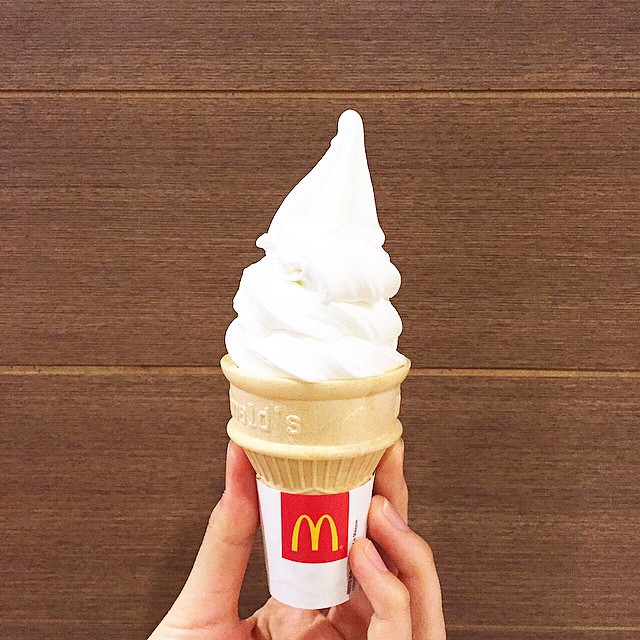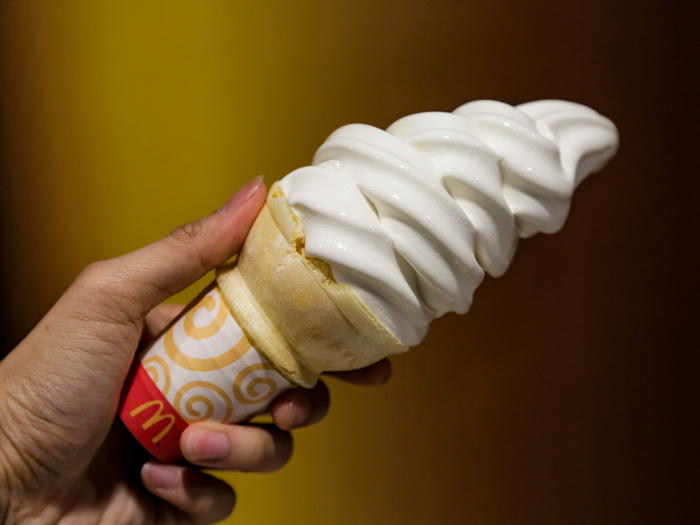Indulging in a delicious McDonald’s ice cream cone is a guilty pleasure for many. But have you ever wondered just how many calories are packed into that creamy treat? In this blog post, we will deconstruct the calorie count of a McDonald’s ice cream cone and explore some savory alternatives for those looking to make healthier choices. Join us as we delve into the making of McDonald’s soft serve and compare it to regular ice cream. Get ready for a flavorful journey that will leave you craving for more – with a side of calorie knowledge, of course!
McDonald’s Ice Cream: A Delectable Journey into Sweetness

mcdonalds ice cream
McDonald’s, a name synonymous with fast food, has etched its name in the annals of dessert history with its delightful array of ice cream treats. From the classic vanilla cone to the decadent McFlurry, McDonald’s ice cream offerings have become a staple in the sweet indulgences of many around the globe. But what makes these frozen delights so irresistible? Is it just the creamy texture and the sweet, comforting flavor or is there more to it? Let’s take a deeper dive into the world of McDonald’s ice cream and explore the caloric impact of these treats on your diet.
The vanilla ice cream cone at McDonald’s, a true classic, is a crowd-pleaser. With its creamy consistency and the perfect hint of vanilla, it’s a simple yet satisfying treat. However, this seemingly innocent dessert packs in about 210 calories. That’s equivalent to a small meal for some!
And it doesn’t stop there. The soft serve sundae, another popular choice, boasts a whopping 310 calories. It might be a delightful treat to your taste buds, but it’s worth considering the caloric implications. It’s like a decadent dessert and a calorie bomb all rolled into one.
So, as you sit back with a McDonald’s ice cream in hand, you might find yourself pondering – are these creamy, dreamy desserts worth the calorie intake? It’s a question that might leave you in a sweet dilemma. But fear not! In the upcoming sections, we will delve deeper into the calorie count of these treats, offering you a comprehensive understanding of what you’re indulging in. Stay tuned as we continue our flavorful journey into the world of McDonald’s ice cream.
Remember, knowledge is power, especially when it comes to making informed decisions about your diet. So, let’s embark on this sweet, enlightening journey together!
Unraveling the Nutritional Facts Behind the Calorie Count

mcdonalds ice cream
Delving deeper into the calorie count of McDonald’s ice cream treats, we find that the McFlurry, a larger and more indulgent dessert option, unsurprisingly tops the list with up to 530 calories. However, it’s crucial to note that these numbers predominantly apply to traditional flavors like the classic vanilla, chocolate, and strawberry. The caloric content of this icy delight is far from being a low-calorie alternative, making it a worthy opponent to any diet plan when you order from McDonald’s dessert menu.
Moreover, the more exclusive McFlurries, such as the M&M and Oreo variants, can pack a whopping 790 calories. This figure is almost half the recommended daily calorie intake for an average adult, making it a treat to be savored sparingly.
However, amid the high-calorie dessert options, there’s a silver lining for health-conscious dessert lovers. The Vanilla Reduced Fat Ice Cream Cone, despite its creamy and indulgent taste, stands at a modest 240 calories. This makes it the most diet-friendly option on the McDonald’s dessert menu for those with a sweet tooth.
However, it’s not just about the calories. It’s equally important to consider the sugar and fat content of these desserts. Most of McDonald’s ice cream treats are high in sugar and saturated fats, which can contribute to weight gain and other health issues if consumed in excess. Therefore, while the Vanilla Reduced Fat Ice Cream Cone may be the lowest calorie option, it’s still essential to enjoy it in moderation, especially if you’re watching your sugar and fat intake.
Ultimately, the key to enjoying McDonald’s ice cream treats without overindulging lies in understanding their nutritional values and making informed choices based on your dietary needs and preferences. Remember, balance is the key to a healthy diet, and occasional indulgence should be part of that balance.
Exploring Healthier Alternatives: The Savory Swap

mcdonalds ice cream
When you’re counting calories, navigating the McDonald’s menu can feel like traversing a minefield of sweet temptations. The ice cream treats, while delicious, are laden with sugar and fat. But don’t despair, there’s a savory haven amidst the dessert deluge. The Grilled Chicken Deluxe Sandwich emerges as a beacon of hope for the health-conscious. This delicious alternative, brimming with flavor and nutrition, is the lowest calorie offering on the menu, clocking in at just 380 calories.
Imagine biting into a succulent grilled chicken patty, nestled between fresh, crisp leaf lettuce and juicy tomatoes, all ensconced within a soft, whole-grain roll. It’s not just a sandwich, it’s a gastronomic delight that satiates your hunger without compromising on your health goals. The Grilled Chicken Deluxe Sandwich is more than just a low-calorie option, it’s a protein powerhouse, providing essential nutrients to fuel your day. Check out if you want to learn how many calories do McDonalds all time favorite fries and cheeseburger have.
Another tempting alternative to the high-calorie desserts is the Grilled Chicken Classic Sandwich. This scrumptious offering is even lighter on the calorie scale, with a mere 310 calories. It’s a delectable blend of grilled chicken, tangy pickles, and zesty mustard on a toasted bun, striking the perfect balance between taste and health.
Both these options are not just low in calories, but also high in protein and low in fat and carbohydrates. They are the epitome of fast food that marries convenience with health, making them an ideal choice for those watching their diet. So, the next time you’re at McDonald’s, remember that there’s more to the menu than meets the eye. You can enjoy a delicious meal without the guilt, and still stay on track with your health goals. For more similar posts like this visit our site and learn when does McDonalds serve lunch and enjoy you favorite meal.
Remember, moderation is key and making informed choices based on nutritional values and personal preferences can help you maintain a balanced diet, even when indulging in fast food.
The Art and Science Behind McDonald’s Soft Serve
The magic of McDonald’s soft serve begins with a carefully crafted base mix. This mix is a delightful blend of cream, nonfat milk, sugar, and a handful of undisclosed ingredients that lend a unique flavor profile to the soft serve. McDonald’s has been perfecting this recipe for decades, ensuring that every lick of their ice cream is a testament to their commitment to quality and taste.
Once the base mix is prepared, it undergoes a meticulous process of pasteurization and homogenization. Pasteurization is a heat treatment process that kills harmful bacteria, making the mix safe for consumption. Homogenization, on the other hand, is a mechanical process that breaks down the fat molecules in the mix, ensuring a smooth and uniform texture. After these processes, the mix is flash-frozen, locking in the flavors and freshness.
When a customer orders a dessert, the magic truly begins. A precise pump dispenses the perfect amount of mix into a state-of-the-art frothing machine. This machine stirs the mix vigorously, incorporating air into it and making it light and fluffy. Simultaneously, the machine flash-freezes the mix, transforming it into the creamy and dreamy soft serve we all know and love.
The final step is the presentation. Depending on the customer’s preference, the soft serve is elegantly dispensed into a crisp cone or a sturdy cup. The swirls of soft serve are a sight to behold, promising a delightful and refreshing treat. For those seeking a bit of variety, certain McDonald’s locations offer specialty flavors like chocolate and strawberry, adding a delightful twist to the classic vanilla soft serve.
At every step of the process, McDonald’s emphasizes stringent quality control. From the choice of ingredients to the preparation and presentation, every detail is monitored closely to ensure the best and safest product for their customers. This commitment to quality is what makes McDonald’s soft serve a beloved treat worldwide.
Soft Serve Vs Regular Ice Cream: A Deeper Dive
When it comes to understanding the difference between soft serve and regular ice cream, it’s not just about the calorie count. The key differences lie in the texture, consistency, and the way they are served. Soft serve ice cream, as the name suggests, is served ‘soft’. This is achieved by incorporating a greater amount of air into the mixture during the freezing process, resulting in a lighter, fluffier texture. This cream-and-air blend can sometimes increase the calorie content, but it’s important to note that soft serve usually contains less fat and fewer calories by volume compared to regular ice cream. This makes it a slightly less guilty indulgence.
However, when we delve into the world of frozen desserts like McFlurries and Blizzards, we enter a high-calorie, high-fat domain. Despite their irresistible taste, these treats can pack a significant caloric punch. For instance, a small Dairy Queen Blizzard boasts about 530 calories and 22 grams of fat, while a regular McFlurry from McDonald’s has around 450 calories and 15 grams of fat. But remember, these numbers can fluctuate based on the brand, flavor, and toppings used, as well as the type of milk or cream.
It’s crucial to remember that not all soft serve ice creams are created equal. The nutritional content can vary dramatically from one brand to another. For instance, premium ice cream flavors like Oreo or M&M McFlurry have a higher calorie count than the original McDonald’s ice cream flavors such as vanilla, chocolate, and strawberry. Therefore, it’s always a smart move to check the nutritional information before indulging in your favorite treat.
While soft serve ice cream might not be the healthiest choice, it’s a popular one due to its creamy texture, affordability, and the myriad of flavors and toppings it can be paired with. Whether it’s a hot summer day or a late-night craving, soft serve ice cream offers a delicious and refreshing treat. Just remember to enjoy it in moderation!
Final Take
McDonald’s, a global fast-food giant, takes diligent measures to ensure transparency in providing information about potential allergens present in their food. However, it’s important to note that despite their best efforts, the risk of cross-contamination during the preparation process cannot be completely eliminated. This is a crucial factor for those with severe food allergies to consider when deciding to indulge in a McDonald’s ice cream treat.
Moreover, McDonald’s continually reassures its customers that their nutritional information is based on standard product formulations and servings. However, it’s worth acknowledging that there may be slight variations due to factors such as product testing, preparation techniques, supply sources, and regional differences. These factors can subtly influence the nutritional values of the ice cream treats, and hence should be taken into account when monitoring your dietary intake.
McDonald’s ice cream, while not the healthiest choice, is a popular treat loved by many for its affordability and variety of flavors and toppings. There’s no denying that every now and then, giving into your sweet tooth and indulging in a cone, sundae, or McFlurry can bring joy and satisfy those spontaneous cravings. However, it’s essential to remember to enjoy these treats responsibly, considering your personal health and dietary needs.
So, the next time you find yourself at McDonald’s, contemplating whether to order that tantalizing ice cream treat, remember this: moderation is key. Whether it’s a cone, sundae, or McFlurry, savoring it in moderation can allow you to enjoy the delight it brings without significantly impacting your health or diet. After all, life is all about balance, isn’t it?
In conclusion, while McDonald’s ice cream may not be the healthiest choice, it’s a delightful treat that can be enjoyed in moderation. Just remember to consider the potential allergens, slight variations in nutritional values, and your personal health and dietary needs before indulging.
FAQ & Users Questions
1. How many calories are in a McDonald’s ice cream cone?
A McDonald’s vanilla ice cream cone contains 210 calories, while a soft serve sundae contains 310 calories.
2. What is the calorie count for larger ice cream orders at McDonald’s?
Larger ice cream orders such as McFlurry have a calorie count of 530.
3. Are there different calorie counts for different flavors of McDonald’s ice cream?
The calorie count mentioned above applies to the original McDonald’s ice cream flavors such as vanilla, chocolate, and strawberry. Premium flavors like Oreo or M&M McFlurry have a higher calorie count.
4. Can you provide the calorie content for McDonald’s premium ice cream desserts?
The calorie content for McDonald’s premium ice cream desserts can range from 620 to 790 calories.
5. Is McDonald’s ice cream considered low calorie?
No, McDonald’s ice cream is not low calorie. The calorie content of McDonald’s ice cream treats ranges from 240-530 calories.
6. How does McDonald’s ice cream compare to other low-calorie options on their menu?
The lowest calorie item on the McDonald’s menu is the Plain Grilled Chicken Deluxe Sandwich with 380 calories. The Vanilla Reduced Fat Ice Cream Cone is the lowest-calorie ice cream option with 240 calories.
7. How is McDonald’s soft serve ice cream made?
McDonald’s soft serve ice cream is made from a base mix of cream, nonfat milk, sugar, and other ingredients. The mix is pasteurized, homogenized, and flash-frozen. When an order is placed, a pump dispenses a pre-determined amount of mix into a machine that stirs and flash-freezes it. The soft serve ice cream is then dispensed into a cone or cup.
8. Is soft serve ice cream a healthy option?
Soft serve ice cream is typically not a healthy option as it contains more sugar and fat than regular ice cream. It also contains artificial flavors and colors. Consuming soft serve ice cream in excess can detract from an overall healthy diet.
9. How does soft serve ice cream differ from regular ice cream?
The main difference between ice cream and soft serve is the texture. Ice cream is thicker and creamier, while soft serve is thinner and smoother. Soft serve is usually made with a mix of cream and air, which gives it a lighter, fluffier texture. Soft serve can also contain less fat and calories per volume compared to regular ice cream.
10. Is dark chocolate a low-calorie option?
Dark chocolate is considered the lowest calorie and lowest fat variety per ounce when compared to other chocolate varieties. However, it still contains some sugar.
11. What is the difference between a McFlurry and a Blizzard?
A McFlurry is a creamy, ice cream-based treat with a swirl of soft serve ice cream and various topping choices. A Blizzard is made with chunkier mix-ins and offers more texture. Blizzard has more calories, fat, and sugar than a McFlurry.
12. What are the calorie and fat contents for a McFlurry at McDonald’s?
The Regular size McFlurry has 340 calories and 9.7 grams of fat, while the Snack size McFlurry has 260 calories and 7.3 grams of fat.
13. Does McDonald’s provide information for customers with food allergies?
McDonald’s provides ingredient information for customers with food allergies on their website. However, there may be a risk of cross-contamination due to shared cooking areas, equipment, and utensils.
